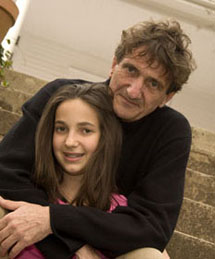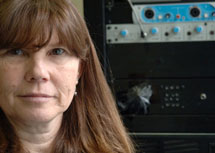| High-tech tools are making it easier than ever for Emory researchers to peek inside infants’ brains, even before birth
Six-month-old Jordan Baumer resembles a tiny astronaut about to undergo a series of experiments at a NASA space station. A green nylon cap studded with twenty-two electrodes conceals her mass of dark hair, and temporary sensors are positioned behind each ear and below an eye.
A research assistant at Emory’s Brain and Cognitive Development Lab has daubed a drop of gel under each electrode to improve the conductivity between the tin sensors and Jordan’s scalp. Colored wires connect to the electrodes and join in a thick rainbow cord that hangs down the back of Jordan’s corduroy jumper and plugs into an electroencephalogram (EEG) headbox that links the wires to an amplifier. As Jordan watches a puppet show designed to keep her still and attentive, she barely notices the electrode cap, but its sensors are reading the voltage from various parts of her brain every four milliseconds, enhancing them up to twenty thousand times and digitizing the information. As the data are recorded and displayed on a monitor in the next room, the EEG allows the researchers to, in effect, peer into Jordan’s brain. There’s a lot going on in there--synapses firing and neural pathways forming, sights and sounds causing blood flow to wax or wane, electrical impulses sending constant, high-speed messages between her brain and her body. Advances in computerized EEGs, ultrasounds, magnetic resonance imaging (MRIs), and other technologies have made it possible for researchers to learn about the developing brain in ways that weren’t imaginable even a decade ago. “Our understanding of the infant world is rapidly emerging from prolonged darkness,” says Professor of Psychology Philippe Rochat, who was awarded a 2006 Guggenheim Fellowship for his work in early childhood development.
 |
Professor of Psychology Philippe Rochat (with daughter Cléo) believes a child’s mind develops in a series of “revolutions.” |
He will use the fellowship to study and write about the developmental origins of sharing and of the sense of possession in children from around the world. This new line of research funded by the Guggenheim fellowship includes three- and five-year-old children from Atlanta as well as children from communist preschools in China, unschooled street children from Recife, Brazil, and children growing up in small fishing communities in the South Pacific.
Rochat’s prior research has focused on the development of a sense of self, early social cognition, and the onset of symbolic representations. In his 2001 book The Infant’s World, Rochat proposed that a baby’s brain develops in leaps he calls “revolutions.”
“Infants are much more sophisticated perceivers, feelers, and thinkers than we once assumed,” says Rochat. “As secret keepers of our origins, infants are the most basic expression of what it means to be alive as humans in this world. Developing infants show us how much is at stake and how much it takes to be functioning adults in a meaningful environment.” Far from the “blooming, buzzing confusion” psychologist William James postulated a hundred years ago, baby’s brains are turning out to be highly organized and remarkably responsive. Recent studies have shown that infants are attentive and able to learn even before they emerge from the womb, and that their brains are much closer to biological hard drives than “blank slates” at birth.  Professor of Psychology Eugene Emory (left) has conducted significant research in prenatal brain development using fetal brain imaging. Professor of Psychology Eugene Emory (left) has conducted significant research in prenatal brain development using fetal brain imaging.
In studies funded in part by a four-year grant from the National Institute of Mental Health, he is using ultrasound technology to detect cognitive activity by measuring blood flow in fetal brains.
One of his most exciting discoveries has been that “blood in the two sides of the brain seems to move at different rates” even when no stimulation is taking place. “The left is faster early in gestation, then the right takes over about the beginning of the third trimester,” he says. In Emory’s studies, conducted at the University’s Briarcliff Campus, Grady Memorial Hospital, and Crawford Long Hospital, he devised a simple yet powerful way to spur brain activity. Pregnant women sing and hum familiar nursery rhymes, such as “Mary Had a Little Lamb” and “Old MacDonald,” while researchers record fetal brain responses using color Doppler imaging--the same technology that weather forecasters use. Emory pulls up a vivid, colorful image of a fetal brain on his computer. The view is straight down from the crown of the head. “You can see the Circle of Willis, at the base,” he says. “It looks like a starfish, with its arms being the major cerebral arteries.” An image so clear would be striking enough from an infant; to have this detailed a view of a fetal brain in utero dazzles neuropsychologists like Emory with the possibilities. “I have so many ideas and no time to develop them all,” he says, gesturing to the journals, books, papers, and letters stacked around his desk. “This is an exciting time in our field.” On the monitor, captured in real time, blood visibly pulses through the arteries of the fetal brain’s left and right hemispheres at a fairly even pace. When the mother starts humming or reciting the nursery rhyme, flow substantially increases in the left hemisphere. While adults generally process verbal information in the brain’s left hemisphere and non-verbal information in the right, this has never before been observed in a fetus, Emory says. “Children are not born lateralized, but it looks as if there is a previously unknown lateral bias,” he says. “It turns out that the [fetal] brain is primed to respond to the spoken word. And one side—the left—appears to already be sensitized or pre-programmed to respond to auditory signals more than the right brain.
“We are seeing this consistently, in nine out of ten fetuses,“ Emory says. “It accompanies a lowered heart rate, which makes us believe the fetus is paying attention.”
After infants are born, the amount of attention they pay to a sound or picture is still the most telling indicator of what is happening in their pre-verbal brain. And since babies can’t talk or fill out a survey, attentiveness is one of the few ways that researchers can measure infant preferences. Among the things babies are universally fascinated by, says Rochat, are their own bodies. A two-month-old will playfully wave and twist her hands in front of her, staring at them while intertwining her fingers or clapping with excitement. This early body exploration, he believes, determines the original core of self-knowledge: “It is with this type of activity that infants specify themselves as differentiated agents in the environment, eventually developing an explicit awareness of themselves.” To wit: we see ourselves, therefore we are. Babies are generally more interested in objects that move than in objects that don’t, and are particularly attuned to faces, even preferring pictures or graphics that are “face-like”—two dots over a straight line—to “non-face-like” images. As early as a few hours after birth, infants will imitate adults’ expressions, going so far as to mimic someone who sticks his tongue out. “Infants do not behave in a social vacuum,” Rochat says, “but rather are actively linking their own behavior to the behaviors of others.” Babies also show distinct preferences—they will look at a picture of their mother’s face longer than at a female stranger’s face, and will look at a face rated by adults as “attractive” longer than at a face rated “unattractive.” Infants recognize familiar voices minutes after birth, orienting their heads toward the sound. And they will actively choose (by how they suck on a pacifier) to hear their mother’s voice rather than a female stranger’s voice. Language acquisition drives Associate Professor of Psychology Debra Mills’s groundbreaking research in the Brain and Cognitive Development lab, tucked behind Emory’s Child Study Center on a tree-lined lot across from the University’s main campus.
 Mills (left) studies how the brain changes over the course of language development, the intricacies of spoken interactions between adults and babies, and the dynamic interplay of neurobiology and linguistics. Mills (left) studies how the brain changes over the course of language development, the intricacies of spoken interactions between adults and babies, and the dynamic interplay of neurobiology and linguistics.
For instance, how does being raised in a bilingual home impact a child’s neural systems? How does a mother’s depression affect her baby’s vocabulary development? One current study at Mills’s lab, for which six-month-old Jordan is participating as a control, involves understanding how the baby’s brain responds to infant-directed speech, more commonly known as “baby talk,” versus adult-directed speech. Infant-directed speech has shorter phrases, lengthened vowels, repetition of key words, and higher pitch: for example, “Look at your little teddy bear! Isn’t that a cute bear! Whose bear is that?” Scientists have found that infant-directed speech is important for helping babies learn language and may increase attention to words said in this manner. “Baby talk” seems almost instinctual to adults, who spontaneously use it when speaking to infants, and it occurs across genders, cultures, and languages. Even older children do it: a nine-year-old will talk differently to a baby than he will to a four-year-old. For adults to understand why this is helpful to babies, says Mills, they need only imagine being in a foreign country where they are minimally proficient in the language. “I was recently in France and could catch only about every fourth or fifth word when people were talking—and even those were completely out of context,” she says. “Imagine how much more I could have understood if people had spoken slowly and in simple phrases, repeating key words until I understood them.” During their first year, babies seem to prefer infant-directed speech, says Mills, but by the time they are toddlers their preferences change. “When the child grows more sophisticated, around twenty months, he or she prefers that adults tone down the sing-songy style,” she says. Six-month-olds are just starting to recognize highly familiar words such as “Mommy” and “Daddy.” At this age, says Mills, infant-directed speech produces more brain activity than adult-directed speech, but only for words the baby hears every day. For a one-year-old, the boost in brain activity to infant-directed speech occurs for both familiar and unfamiliar words. A few months later, when the child has a vocabulary of a hundred words, give or take, the brain still responds more to infant-directed speech, but only for new words. In the beginning of the second year, babies become “word-learning machines. They’re not talking much yet, but they’re taking it all in.” Rochat, himself a father of three, has long been mesmerized by how babies develop and the motivation that drives them from one accomplishment to the next.
“We underestimated the complex ways they have of construing themselves, the world, and others,” he says. “The unveiling of this ‘competent infant’ forced a revision of the whole field of developmental psychology.”
Rochat believes there are “revolutions” in cognitive development as radical for the infant as regime change is to a society. The first occurs at two months, when babies begin to “ponder and assess” their environment. “At this juncture, infants grow from being direct perceivers and actors to active thinkers, evaluators, and planners,” he says. Two-month-olds are spending longer periods awake and alert, “open to the world around them.” Parents often report that this is the point when their babies begin “smiling real smiles” at them, and they feel as if they are truly greeting their child for the first time. At nine months, Rochat says, babies experience another mental revolution: they begin to understand that other people are deliberate in their actions, just as they themselves are. For instance, if the baby is looking at a bright red ball on the living room floor, they might check to see if another child is looking at it too. This is the beginning of cooperation and sharing—and perhaps of jealousy and coveting as well. Other actions that develop around the nine-month mark include pointing, and looking where someone else is looking (“gaze following”). Heading into their second year, however, is when babies make a leap that will change their world forever: they begin to think symbolically. Words suddenly have meaning beyond the tangible realities of cup, dog, hot, cold, hi, and bye. “When the symbolic gateway is opened . . . the child gains immensely,” Rochat says. “They can now contemplate the world, reenact past events, imagine virtual realities, and [predict] future outcomes. They can exchange abstract ideas with others using words, gestures, drawings, or mathematical formulas. They can express love, hate, bliss, boredom, or the blues. “Symbolic functioning makes for the uniqueness and power of human culture, for better and for worse. It’s what makes us different from any other animal. This is what infants prepare for and develop for during the whole first part of life.” |